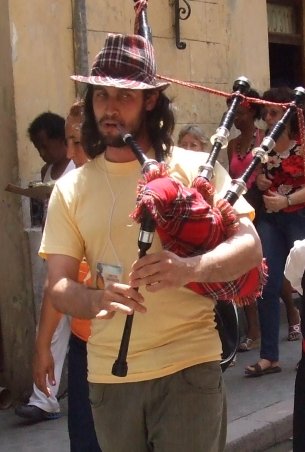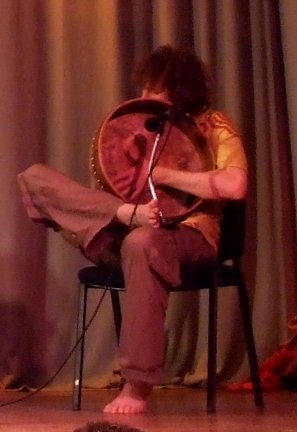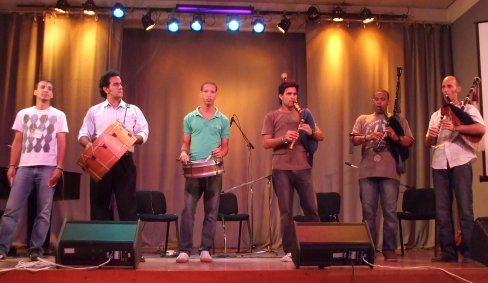Celtic Music in Havana
Text and Photos by Irina Echarry

HAVANA TIMES, April 28 — “A festival of what?” one woman asked, as she watched a parade to the pipers moving down calle Obispo in Old Havana. When she found out that it was a festival of Celtic music and tradition, her face grimaced as she wondered, “Are there really that many followers of that culture in Cuba?”
That same question was posed by many people. But from April 6 to 13, Havana residents could enjoy a different atmosphere. Bagpipes, violins and guitars celebrated the musical inheritance that migrated from European Celtic nations to the western hemisphere.

The Casa de la Poesía, the Centro Hispanoamericano as well as the Office of the City Historian were settings in which the performances were given by Irish artists Kilian Kennedy, Ryan McDonald and James P. Troy (on Highland bagpipes); Mary Jane Lamond (singing Gaelic songs), Liam O Maonlaoi (who constantly interacted with Cuban musicians), accordionist Niamh Ni Loud, the bagpipe band of Eduardo Lorenzo and the Centro Asturiano de la Habana.
The public in attendance was well defined: the majority was younger people between the ages of 25 and 40, in addition to rock music lovers.
One spectator, Gustavo —sporting a beard and long hair plaited into a braid— smiled to the chords of the duo made up of violinist Ward McDonald and guitarist Tim Chaisson. “I love this music,” he said. “Not only do I hear it, but I feel it deep in my being. I don’t know if in another life I was Celtic (laughing). But no, seriously, it’s a privilege to be able to see such fine musicians and not have to pay a dime… It was a great idea to put on the festival; magnificent artists have come here. Look, I never expected to listen to O Maonlaoi live. I was familiar with his recordings; some friends of mine in Canada sent them to me… But now I can see him playing barefooted with my own eyes…”

Old Havana —which centuries ago greeted Catalan, Basque, Galician, Scottish and Irish immigrants— now welcomed the traditional parades of bagpipe bands, conferences, workshops (on singing, dancing and musical instruments such as the traditional violin, accordion and bagpipes), in addition to concerts.
For Alberto, a young worker at the Ministry of Health, not everything was rose colored: “The foreign guests are superb, but what I don’t like listening to are Cuban artists singing traditional Irish songs. I don’t know, that passion strikes me as funny… it seems like they’re faking… just like some of the apparently fanatical audience… you see them there gathered here as if they were waiting for some god of the Irish pantheon, but those are the first people who when they leave the country start making their living giving salsa lessons…”
According to Marcel Nazabal, a young piper and one of the organizers of the event, “Our objective is to make this an annual event… It’s a job that requires a lot of effort by several national and international institutions. This festival is the little brother of the great Celtic Colors, which takes place in Cape Breton in October every year; its president, Jackeline Taylor, has helped out a great deal so that we can enjoy what we’ve achieved.”
The followers of Celtic music and tradition in Cuba now have their event. It’s good that there’s a space for everyone. All and all, our culture is a mixture of many others.






Congratulations Cuba, Organisers, Musicians from Ireland, Canada and Cuba and the Audience whose enthusiasm and talent for Irish ceilidh dancing was impressive! I’m researching the little known story of roughly 1,000 Irish immigrants (also Scottish and English), who went to Cuba in 1835 to work on the construction of the first railway between La Habana and Guines. Along with African and Creole slaves they formed gangs of indentured labour working under brutal conditions to lay the tracks of Cuba’s first sugar rail road. No doubt the Bata and the Bodhran have met before, all those years ago in Havana. The Cuban Archives hold the records of Patrick O’ Rourke from Waterford who was fined for allowing slave workers on the rail road to play their Bata drums into the night. The Irish language was spoken along the tracks of the line together with African languages, Spanish, Chinese and English. The spirit of Irish music has been lying dormant in Cuban cultural memory all this time!
Irina!
Thank you for covering our first CeltFest Cuba. We are already organising next year. We have a shoestring budget so we are very appreciative of publicity. I want to take this opportunity to thank Culture Ireland for funding the Irish artists so they could attend the event.. Like Gustavo I was very happy to meet these Irish artists for the first time. I was very intrerested to read Alberto’s point of view too and I think I understand what he is saying. When I see Cuban Celtic artists what I would like to hear is the folk music that was brought to Cuba from Northern Spain. Galicia and Asturias are considered Celtic Nations. Traditional instruments like the gaita (bagpipe) were brought to Cuba by the early immigrants. It is true that Irish music is Celtic, but not all Celtic music is Irish!
We would have loved to have been there for this, the inaugaral year of Celticfest Cuba…. but maybe another year. It sounds like a wonderful event and I hope that it will continue for many more years.
En seguida haremos la correción. Gracias por señalarlo.
Hola Irina,
Soy Marcel Nazabal, el Director cubano del primer Festival de Música y tradiciones celtas CeltFestCuba. Quería agradecerte por tan bonito artículo con presencia de opiniones positivas y negativas por parte de la audiencia, de las opiniones negativas también nos nutrimos para aprender a hacer las cosas mejor y sobre todo para trabajar más en trasmitir el mensaje que lleva este festival, que agrupa la pasión por la música celta de muchos que según mi opinión la música que uno ama no tiene un idioma en particular, solo tiene el sabor y el sentimiento que lleva.
Por favor quería hacerte una corrección muy importante, el último pie de la imagen que publicas no corresponde a la banda de giatas del centro asturiano de la Habana, sino a la Banda de Gaitas de Eduardo Lorenzo, si pudieras arreglar este error lo antes posible te estaremos muy agradecidos, no queremos herir los sentimientos de ninguno de los artistas. Puedes escribirme a mi correo personal…